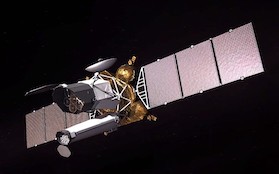
The Spectr-Roentgen-Gamma (SRG) is
a Russian-German high energy astrophysics mission launched on July 13, 2019
from the Baikonur Cosmodrome. After travelling to the Earth-Sun L2 Lagrange
point, the instruments began the first of eight planned sky surveys in December
2019. Mission plans call for four years of operations in scanning mode, building
all-sky maps over the course of six months. Once completed, the observatory
with shift to pointed observations at specific targets of interest.
The original mission calls for seven years of operations.
The mission occasionally appears as “Spectrum X-Gamma”
(SXG) in English. X-rays are often refered to as Röntgen or Roentgen
rays in other countries (and in the case of this mission specifically, in
Russia and Germany) named after their discoverer Wilhelm Conrad
Röntgen.
Despite the “Gamma” appelation in the mission name, the satellite
carries no gamma-ray instrument. The reference was retained for historical
reasons, as the mission’s earlier proposals called for additional
gamma-ray detectors.
Mission Characteristics
 Lifetime
Lifetime : December 8, 2019–present
 Energy Range
Energy Range : 0.2–30 keV
 Special Features
Special Features : X-ray mirror optics combine moderate resolution
imaging with a very wide field of view, with all-sky maps to be produced
over a wide range in the soft to hard X-ray range.
 Payload
Payload :
- The Extended Roentgen Survey with an Imaging Telescope Array (eROSITA)
instrument consists of seven telescopes with 54 nested mirror segments to
focus X-rays onto a CCD detector (0.2-10 keV) with an on-axis 18 arcsec HEW.
The Filed of view is 0.81 sq deg and the energy resolution is 138 eV at 6 keV.
The instrument
and mirrors were built by the Max Planck Institute of Extraterrestrial
Physics, using a CCD design based on the successful XMM-Newton CCD detectors.
They are active cooled to -90° C for improved sensitivity.
- The Astronomical Roentgen Telescope - X-ray Concentrator (ART-XC) is also
an array of seven telescopes in a nested shell design, though with fewer mirror
segments (28 per telescope) and a 45 arcsecond resolution in a 36 arcminute
field of view spanning 5–30 keV.
The detector unit in each telescope is a CdTe crystal with double-side strip
detectors with an effective area of 400 cm2 and 1.2 keV @ 14 keV
spectral resolution and a timing resolution of about 1 ms. The instrument
was build at the Russian State Nuclear Center and the iridium-coated
mirror system was developed and
calibrated at NASA’s Marshall Space Flight Center.
 Science Highlights
Science Highlights:
- First all-sky imaging in the X-ray hard band
 Archive
Archive: The HEASARC hosts the eROSITA data.